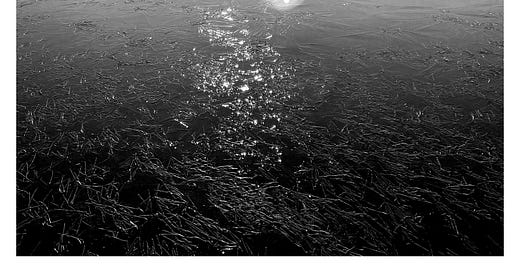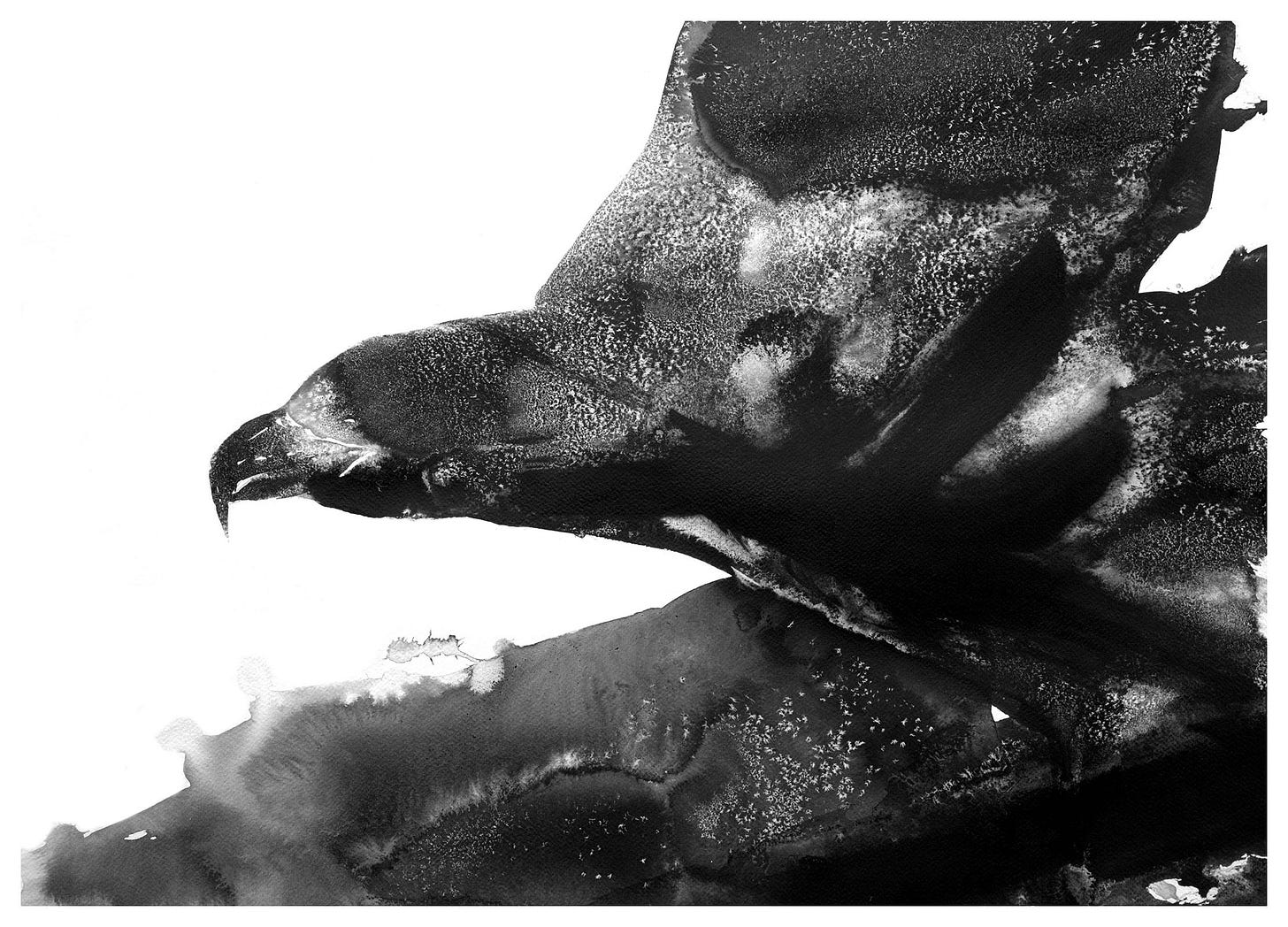Friends,
This is an Into the Deep Woods story for all subscribers.
If you’re a paid subscriber there is also a podcast version, featuring my dulcet tones reading the piece with some overlaid watery sounds and cello music. I hope it will enhance your sense of calm in this otherwise frantic world.
Click on the button below to access the podcast. Otherwise, read on . . . I hope you enjoy the story.
There’s an almost circular pool high on the ridge with a pyramid of stones standing in its centre like a prehistoric water monument, a cairn with a moat. It’s an important landmark on the hill, the place where everyone is drawn, wild and human, and one of the few water sources for the ponies. I don’t know how they survive up there all winter, with no supplemental feed and just scrags of grass to eat. Recently, after days of sub-zero temperatures the pool froze hard, the ice layer as thick as my hand. When I arrived up there early one morning I saw the ponies collected around it, looking forlorn and thirsty. I spent half an hour trying to crack the edge of the ice with my boots, an impossible task. As I apologised to the little, barrel bellied mares for my lack of assistance a grey picked up her head, watched me for an instant, then took a step onto the ice, which split with a loud crack. She dipped her head and began to drink from the hoof shaped hole she’d punched in the surface. It made me remember a line I read from a now forgotten source years ago: How did nature cope without us for 3 billion years . . ?
I don’t know how long it’s been since I last put on a pair of ice skates but I’m tempted. In fact if another cold spell comes I’ll buy a pair because the pool is the perfect place for it. I can’t think of anything more joyful in winter than sliding around its edge with a 360 degree view across the Welsh mountains and the Herefordshire hills with the sun blazing low on the horizon and the ponies watching me, with their eternally polite and suspicious eyes.
When I was a boy I was strongly advised never to go near a frozen pond. I duly obeyed until one snowy night, after stealing a bottle of something too potent for young teenagers, a friend and I walked out to the centre of the park lake with a metal rod to see if we could bore a hole in the ice. This we managed to do. As the first lick of water appeared the most beautiful and haunting moaning began around us as the ice tried to hold us up. Then it let go. My friend went through up to his chest and survived by sprinting the two miles home to keep his body temperature up. I noticed this same temptation in my own boys when they were growing up. Ice was meant to be walked on, tested, shattered, punched through, lifted up, licked, stared at. As a remedy for my own far too cautious upbringing this was encouraged. A favourite game up on the high pools was a form of child curling, where my boys lay down on their fronts, I lifted them up by the back of their coats, took a swing and then slid them right across the pool. Loud giggles and “wheeeeeeeeeeeeee” noises followed. The thickness of the ice may not have been rigorously tested beforehand but both boys were very happy to sign their disclaimers with an X.
There’s a video I look up online once in a while when I’m feeling lost. It shows a deer on a beach approaching, running back from, then plunging into the surf, leaping and bounding, filled with surprise and wonder. It reminds me that joy is a universal thing experienced by all species, and often around water.
Our freezes are short and rare here, sometimes only 2 or 3 days over a winter, so the potential for ice fun is limited. I’ve been trying to discover alternatives, on the days of soft rain, or soaking rain, or biblical storms. I think I’ve found one. An alternative route up to the ridge takes you through a steep beech wood and then onto a forestry track between acres of larch and pine. On one side is a scooped out wall of layered mudstone coated with star moss and lichen. Here and there puddles collect at the base of the rock and I’ve taken to mapping out the little springs that appear after rain. The water is filtered through layers of pine needles and leaf mould, clay, gravel and stone. It leaks out in little spouts just big enough to cup your hands beneath, to bend and drink. This cloud fresh water is as delicious as wine when drunk straight from the spring. It has no resemblance whatsoever to the plastic particle infested, litter creating, ocean polluting substance that people refer to as bottled mineral water.
When I was a boy I thought water tasted of nothing. It was the base substance into which flavour was added - the filler, the blank. My sense of taste lacks sensitivity but it’s developed since then. Spring water tastes of sky, of storms and mist, of fractures in stone, underground rivers, never to be unearthed fossils, of lava and extinct volcanoes, of a fox’s silent footsteps, of feathers fallen from a buzzard’s nest. These are the things I’ve begun to imagine as I sip from my cupped hands.
The spring in the wood dried up when the cold spell arrived, but it’s warm and wet again now, two named storms in the past 3 days. I’m writing this as Storm Jocelyn is beginning to push against the windows and tap on the roof. Later, when the wind is full force I’ll go for a walk, try to avoid the falling trees, and see if the spring has started to flow. It may not have because it flows the way the imagination flows, does its own thing, makes its own time. It slips into the dark, finds hidden seams and flows back out into the light when it’s absorbed some of the fragments of the place.
I sometimes spend hours staring at a wall, waiting for the words to come. Or days trying to find a shape on a sheet of paper. At other times the words stutter, or they come out in a rush, tangled and knotted. The shapes appear all wrong and are erased or painted over. Yesterday I fought a stooping owl for 8 hours solid, trying to find the wildness in it. I started too timidly, with little brushes, feint marks, trepidations. Slowly the trickle of inspiration began to pour and late in the evening the image came to life beneath a layer of white ink I’d thrown over it, straight from the bottle, while the painting was propped up in the bath. Then I blasted it with a jet of water from the shower and the layers of ink flaked off or dissolved, revealing the wild owl beneath. This washing process is the most important part of the work, the part I least control. Wildness is in the water.
The rain is really coming down now. I can hear the hiss of tyres going through pools on the street, and my window is the skin of a drum. Apparently a 1km square cumulus cloud weighs 500,000 tons. The storm clouds flowing over us now cover most of the country. All that water landing, seeping in, flowing down, collecting. It’s time for me to go out and check the spring.
Paragraphs and Paint
Thanks for reading this week’s story. Next week I’ll be publishing the second in the Rima series which is all about fragments, fractures, how stories assemble themselves from pieces, how they travel and transform. Last week’s story explored presences in the landscape and how our places impose themselves on our imaginations.
I now spend most of my time working on these stories, which is an adventure. I work in a loft room at the top of our old house. On one side is my writing desk and on the other is my painting desk. In between are rows and rows of books (and a strangely incongruous turquoise shag pile rug which soaks up all the paint splashes). My working day involves pacing backwards and forwards between desks, adding paragraphs and paint to blank pages.
If I had to define a main purpose for my writing it would be to learn how to imagine from the wild heart of a place. News seems to be spreading about this series now and I’m grateful for that. I’m also grateful to the people who are now supporting my work through a paid subscription. I still have a way to go to make this project self supporting, so if you like the work so far and if you’re inspired by the themes please consider a paid subscription. The series is a resource for those who want to imagine wildly. It costs less than a coffee and cake, and contains zero cholesterol . . .
Thanks again!
Found Things
As part of my research for the Rima series I’ve been reading (with an admittedly random and disorganised methodology) stories about this area in the medieval period. I recently rediscovered Kevin Crossley Holland’s The Seeing Stone, the first book of a trilogy I bought for my boys when they were at school and which, for some reason, I never read. The book is set in the Welsh Marches in the late 12th century and tells the parallel stories of a boy who wants to become a knight, and the mythical tale of King Arthur and Merlin. It is stunningly written. He compresses the story into short, jewel-like chapters. The border area has grown and deepened in my imagination since I started reading it. I have no idea why some novels are classed as children’s books and therefore go mostly unread by adults. Holland’s work is in a category of its own - he’s a poet of place and a master storyteller. I rate him very highly.
The book can be found on the publisher’s website here
I came across this YouTube video about an elderly man who has lived off grid in the Appalachian mountains for 50 years. He’s built all the structures on his land by hand using foraged materials and he’s grown an incredible food and herb garden. He’s led a rich, connected, simple life inspired by Taoism and is now trying to educate people to look after the land in the same way. It’s a low key, hand-held documentary, but it’s worth watching as he’s an inspiring character, an example of the riches of auto-didacticism.
News - The Wonder and the Wild
This flying hawk is one of three pieces showing at the beautiful Gallery at Home in an exhibition called The Wonder and the Wild. The show opens on Saturday 3rd February and runs until March. Gallery at Home was selected by the Guardian as one of the best galleries in the UK, so it’s well worth a visit.
You can find out more on their website:
Until next week, J








The video is very interesting. One thing I've noticed with people living out in the wild is that most have a large library of books, no matter how remote their dwelling is. That says a lot about the importance of literature in our lives. Definitely a staple of our existence.
This was exactly what I wanted on this grey, rainy morning in my part of the world. I read every single word. Lovely.